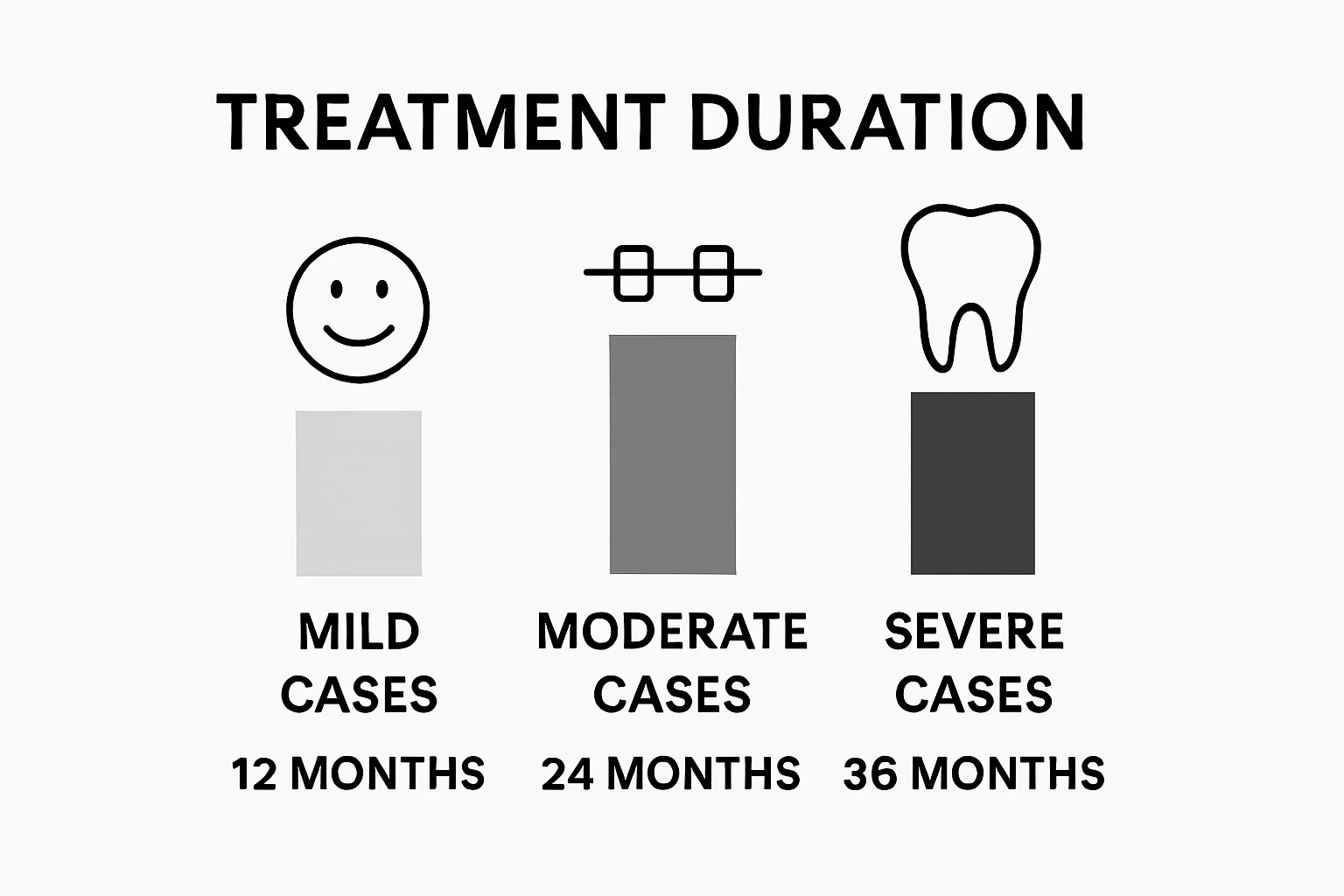Understanding How Long Braces Last: Key Insights
October 5, 2025
Understanding How Long Braces Last: Key Insights
Braces are often seen as a ticket to a perfect smile and they use high-tech wires and custom brackets to shift teeth slowly over time. Think that is all about looks? Actually, the most surprising part is how braces tackle serious oral health issues and not just straighten crooked teeth. Studies show that braces can even help lower the risk of gum disease and jaw pain. The science behind these tiny brackets reaches far beyond cosmetic change and reveals an entire hidden world of health benefits.
Table of Contents
- What Are Braces And Their Purpose?
- Why Is The Duration Of Braces Important?
- Factors Affecting How Long Braces Last
- What To Expect During Orthodontic Treatment
- The Role Of Aftercare In Maintaining Results
Quick Summary
| Takeaway | Explanation |
|---|---|
| Braces align teeth for function and beauty | Braces gradually reposition teeth, improving both dental health and aesthetic appearance. They are vital for a balanced smile. |
| Personalized treatment plans are essential | Orthodontists create individualized plans considering factors like jaw development and tooth crowding for optimal results. |
| Braces duration varies by individual conditions | Treatment time differs based on severity of misalignment, patient age, and biological response. Personalized timelines are crucial. |
| Patient compliance significantly affects outcomes | Regular adherence to care guidelines, such as hygiene and appointment attendance, is vital for effective treatment progress. |
| Aftercare is crucial to prevent relapse | Wearing retainers post-treatment stabilizes teeth and prevents movement regression, ensuring long-term results and maintaining your investment. |
What Are Braces and Their Purpose?
Braces represent a specialized orthodontic treatment designed to gradually align and correct teeth positioning, improving both dental functionality and aesthetic appearance. These custom-designed dental appliances apply consistent, gentle pressure to reposition teeth over time, helping patients achieve a healthier, more balanced smile.
Understanding Dental Alignment Technology
At their core, braces work through a sophisticated biomechanical process that manipulates tooth positioning. According to the National Institute of Dental and Craniofacial Research, orthodontic devices utilize several key components to create controlled movement:
- Brackets: Small metal or ceramic attachments bonded directly to individual teeth
- Archwires: Thin metal wires that connect brackets and generate repositioning pressure
- Bands: Supportive rings that anchor the entire orthodontic system
These interconnected elements work synergistically to apply precise, calculated force that gradually shifts teeth into their optimal alignment.
The process involves subtle bone remodeling, where pressure causes bone cells to break down and rebuild around the tooth’s new position.
Treatment Goals Beyond Aesthetics
While many people associate braces with cosmetic improvements, their purpose extends far beyond creating a beautiful smile. Orthodontic treatments address critical functional concerns that impact overall oral health. Medical research from the American Association of Orthodontists highlights several key therapeutic objectives:
- Correcting bite misalignments that can cause jaw pain
- Preventing potential speech impediments
- Reducing risks of tooth decay and gum disease
- Improving chewing efficiency and digestive processes
Professional orthodontists carefully assess each patient’s unique dental structure, developing personalized treatment plans that consider factors like jaw development, tooth crowding, and individual growth patterns. The goal is not just straightening teeth, but creating a harmonious, functional oral ecosystem that supports long term health.
Why Is the Duration of Braces Important?
The length of time an individual wears braces is not a random process but a carefully calculated treatment strategy that significantly impacts overall orthodontic outcomes. Understanding the duration of braces helps patients set realistic expectations, plan for potential lifestyle adjustments, and comprehend the complex biological processes underlying dental realignment.
Personalized Treatment Timelines
Orthodontic treatment duration varies dramatically based on individual dental conditions. According to clinical research from the American Journal of Orthodontics30571-5/fulltext), several critical factors influence treatment length:
- Severity of Dental Misalignment: More complex cases require extended treatment periods
- Patient Age: Younger patients often experience faster tooth movement
- Biological Response: Individual bone density and healing rates impact realignment speed
While some patients might complete treatment in as little as 12 months, others may require up to 36 months of continuous orthodontic intervention.
 This variability underscores the importance of personalized treatment planning and patient-specific approaches.
This variability underscores the importance of personalized treatment planning and patient-specific approaches.
Psychological and Functional Implications
Beyond physical alignment, the duration of braces carries significant psychological and functional implications. Research published in the European Journal of Orthodontics reveals that prolonged orthodontic treatments can impact patient motivation, self-perception, and social interactions.
Key psychological considerations include:
- Managing patient expectations throughout the treatment journey
- Maintaining patient compliance and enthusiasm
- Addressing potential self-esteem challenges during extended treatment periods
By understanding the intricate relationship between treatment duration and individual dental needs, patients can approach orthodontic care with greater patience, realistic expectations, and a commitment to achieving optimal dental health.
Factors Affecting How Long Braces Last
The duration and effectiveness of orthodontic treatment depend on a complex interplay of biological, behavioral, and clinical factors. Understanding these variables helps patients and orthodontists collaborate more effectively to achieve optimal dental alignment and minimize potential treatment complications.
Patient-Specific Biological Considerations
Research from the International Journal of Orthodontics demonstrates that individual physiological characteristics significantly influence orthodontic treatment progression. Key biological factors include:
- Bone Density: Determines how quickly teeth can be repositioned
- Metabolic Rate: Impacts cellular regeneration and tissue adaptation
- Hormonal Variations: Can affect tooth movement speed
Genetic predispositions play a crucial role in determining how an individual’s body responds to orthodontic intervention. Some patients experience faster tooth movement, while others require more extended treatment periods due to inherent biological differences.
Lifestyle and Compliance Factors
Patient behavior represents another critical determinant of braces duration. Consistent adherence to orthodontic guidelines dramatically influences treatment outcomes. Essential compliance elements include:
- Following recommended oral hygiene protocols
- Attending all scheduled adjustment appointments
- Wearing prescribed additional appliances like rubber bands
- Avoiding foods that might damage orthodontic equipment
External Treatment Influences
External factors can unexpectedly impact braces duration. Professional orthodontists carefully monitor and adjust treatment plans to account for potential complications. These considerations might include:
- Unexpected tooth movement resistance
- Minor dental structural anomalies
- Potential impact of underlying medical conditions
By understanding and proactively addressing these multifaceted factors, patients can work collaboratively with their orthodontists to optimize treatment efficiency and achieve desired dental alignment outcomes.
What to Expect During Orthodontic Treatment
Orthodontic treatment represents a comprehensive journey that involves more than simply wearing braces. Patients enter a carefully managed process designed to transform their dental alignment, requiring both physical adaptation and consistent engagement with their orthodontic care team.
Initial Assessment and Preparation
The American Association of Orthodontists emphasizes that the treatment journey begins with a thorough diagnostic phase. Patients can anticipate:
- Comprehensive dental imaging and 3D scans
- Detailed consultation about treatment objectives
- Personalized treatment plan development
- Discussion of potential appliance options
During this initial stage, orthodontists create a precise roadmap tailored to each patient’s unique dental structure. The goal is to develop a strategic approach that addresses individual alignment challenges while maintaining overall oral health.
Physical Adaptation and Comfort Management
The physical experience of orthodontic treatment involves gradual adjustments and potential temporary discomfort. Patients will encounter several predictable physiological responses:
- Mild pressure and sensitivity after initial appliance placement
- Periodic adjustment of brackets and wires
- Potential temporary speech modifications
- Gradual reduction in dental sensitivity over time
Lifestyle and Maintenance Considerations
Successful orthodontic treatment requires active patient participation. Key lifestyle modifications include:
- Adopting specialized oral hygiene techniques
- Avoiding certain foods that might damage orthodontic hardware
- Wearing supplementary appliances like rubber bands
- Maintaining consistent follow-up appointments
These adjustments ensure optimal treatment progression and help patients achieve their desired dental alignment outcomes. Patience and commitment are essential throughout the orthodontic journey, transforming temporary inconveniences into long-lasting dental health improvements.
The Role of Aftercare in Maintaining Results
Orthodontic treatment does not conclude with the removal of braces. The post-treatment phase represents a critical period where patients must actively engage in maintaining their newly aligned dental structure. Successful aftercare prevents potential tooth movement regression and ensures long-term orthodontic investment.
Retainer Protocol and Importance
Clinical research published in the American Journal of Orthodontics demonstrates the pivotal role of retainers in stabilizing tooth positioning. Key retainer considerations include:
- Fixed Retainers: Thin wires bonded behind teeth
- Removable Retainers: Clear plastic or wire appliances
- Nighttime Retention: Extended wear during sleeping hours
- Gradual Reduction of Wear Time: Transitioning from full-time to nighttime use
Retainers function as a critical biological stabilization mechanism, allowing surrounding bone and soft tissues to adapt to new tooth positions and prevent potential relapse.
Below is a comparison table outlining the different types of retainers and their key features, as described in the aftercare section to help patients understand their post-braces options.
| Retainer Type | Description | Wear Protocol | Purpose |
|---|---|---|---|
| Fixed Retainer | Thin wire bonded behind teeth | Worn continuously, not removable by patient | Stabilizes tooth position long-term |
| Removable Retainer | Clear plastic or wire appliance | Usually worn full-time initially, then at night | Maintains new alignment, easy to clean |
| Nighttime Retention | Retainer worn only during sleeping hours | Used after initial full-time period | Prevents minor movement overnight |
| Gradual Reduction | Transition from full-time to nighttime wear | Based on orthodontist’s instructions | Allows bone and tissues to stabilize |
Long-Term Monitoring Strategies
Post-braces care extends beyond personal maintenance and includes professional oversight. Patients should anticipate:
- Regular dental check-ups
- Periodic orthodontic consultations
- Comprehensive oral health assessments
- Potential minor adjustments to retainer fit
Lifestyle and Maintenance Considerations
Successful aftercare requires patients to integrate specific habits into their daily routine:
- Consistent retainer cleaning
- Avoiding extreme temperature changes with retainers
- Protecting retainers from physical damage
- Maintaining excellent oral hygiene
By understanding and implementing comprehensive aftercare strategies, patients can preserve their orthodontic investment and maintain a healthy, aligned smile for years to come. The commitment to post-treatment care determines the long-term success of orthodontic intervention.

Ready for a Straighter Smile Without the Guesswork?
Uncertain how long braces will take or worried about the hassle of achieving your best smile? This article covers the key questions about orthodontic timelines, highlighting how individual needs, commitment, and expert guidance can change your experience. At Glow Orthodontics, we understand that every patient wants clear answers and a caring team on their side. Our skilled orthodontists use the latest technology to create personalized treatment plans, whether you are interested in traditional braces or Invisalign. Your comfort, progress, and final results are just as important as the timeline.

Why wait to see lasting results and feel more confident with your smile? Visit Glow Orthodontics to learn about our patient-centered approach, real success stories, and easy online appointment scheduling. Book your free consultation and take your first step toward an aligned, radiant smile today. Your journey to a healthy bite and a glowing look starts here.
Frequently Asked Questions
How long will I need to wear braces?
The duration of braces treatment typically ranges from 12 to 36 months, with the exact time depending on individual dental conditions such as severity of misalignment and biological response.
What factors influence how long braces last?
Several factors affect braces duration, including the severity of dental misalignment, patient age, biological response to treatment, lifestyle choices, and adherence to orthodontic guidelines.
What can I do to ensure my braces treatment is effective and timely?
To promote effective treatment, maintain consistent oral hygiene, attend all scheduled appointments, follow your orthodontist’s instructions, and avoid foods that could damage the braces.
What happens after I get my braces off?
After braces removal, patients must wear retainers to stabilize their new tooth positions, and ongoing dental check-ups are necessary to monitor oral health and retention effectiveness.